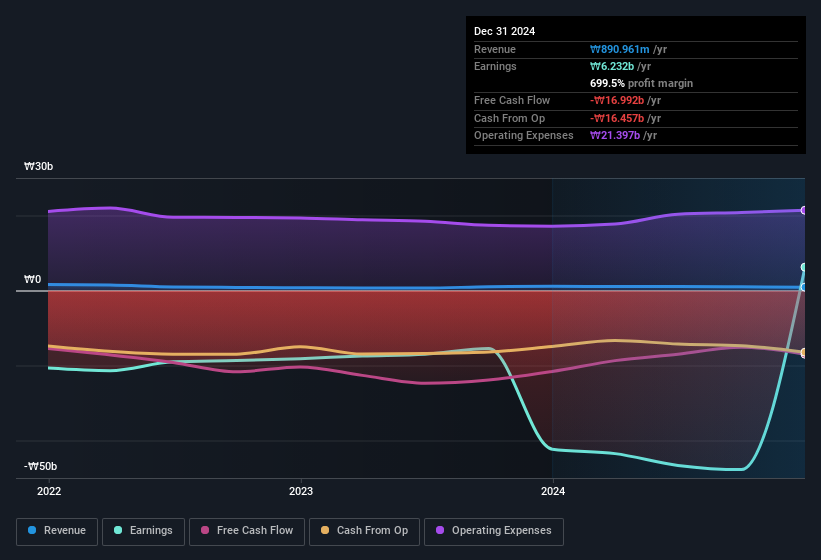- South Korea
- /
- Biotech
- /
- KOSDAQ:A199800
ToolGen's (KOSDAQ:199800) Earnings Might Not Be As Promising As They Seem

ToolGen Incorporated's (KOSDAQ:199800) solid earnings report last week was underwhelming to investors. We think that they may be worried about something else, so we did some analysis and found that investors have noticed some soft numbers underlying the profit.

A Closer Look At ToolGen's Earnings
One key financial ratio used to measure how well a company converts its profit to free cash flow (FCF) is the accrual ratio. The accrual ratio subtracts the FCF from the profit for a given period, and divides the result by the average operating assets of the company over that time. You could think of the accrual ratio from cashflow as the 'non-FCF profit ratio'.
Therefore, it's actually considered a good thing when a company has a negative accrual ratio, but a bad thing if its accrual ratio is positive. That is not intended to imply we should worry about a positive accrual ratio, but it's worth noting where the accrual ratio is rather high. That's because some academic studies have suggested that high accruals ratios tend to lead to lower profit or less profit growth.
ToolGen has an accrual ratio of 0.95 for the year to December 2024. Statistically speaking, that's a real negative for future earnings. To wit, the company did not generate one whit of free cashflow in that time. Even though it reported a profit of ₩6.23b, a look at free cash flow indicates it actually burnt through ₩17b in the last year. We also note that ToolGen's free cash flow was actually negative last year as well, so we could understand if shareholders were bothered by its outflow of ₩17b. Unfortunately for shareholders, the company has also been issuing new shares, diluting their share of future earnings. The good news for shareholders is that ToolGen's accrual ratio was much better last year, so this year's poor reading might simply be a case of a short term mismatch between profit and FCF. Shareholders should look for improved cashflow relative to profit in the current year, if that is indeed the case.
Note: we always recommend investors check balance sheet strength. Click here to be taken to our balance sheet analysis of ToolGen.
To understand the value of a company's earnings growth, it is imperative to consider any dilution of shareholders' interests. As it happens, ToolGen issued 7.9% more new shares over the last year. Therefore, each share now receives a smaller portion of profit. To talk about net income, without noticing earnings per share, is to be distracted by the big numbers while ignoring the smaller numbers that talk to per share value. Check out ToolGen's historical EPS growth by clicking on this link.
How Is Dilution Impacting ToolGen's Earnings Per Share (EPS)?
ToolGen was losing money three years ago. Zooming in to the last year, we still can't talk about growth rates coherently, since it made a loss last year. What we do know is that while it's great to see a profit over the last twelve months, that profit would have been better, on a per share basis, if the company hadn't needed to issue shares. And so, you can see quite clearly that dilution is influencing shareholder earnings.
If ToolGen's EPS can grow over time then that drastically improves the chances of the share price moving in the same direction. However, if its profit increases while its earnings per share stay flat (or even fall) then shareholders might not see much benefit. For that reason, you could say that EPS is more important that net income in the long run, assuming the goal is to assess whether a company's share price might grow.
Our Take On ToolGen's Profit Performance
In conclusion, ToolGen has weak cashflow relative to earnings, which indicates lower quality earnings, and the dilution means that shareholders now own a smaller proportion of the company (assuming they maintained the same number of shares). For the reasons mentioned above, we think that a perfunctory glance at ToolGen's statutory profits might make it look better than it really is on an underlying level. If you want to do dive deeper into ToolGen, you'd also look into what risks it is currently facing. For example - ToolGen has 2 warning signs we think you should be aware of.
Our examination of ToolGen has focussed on certain factors that can make its earnings look better than they are. And, on that basis, we are somewhat skeptical. But there is always more to discover if you are capable of focussing your mind on minutiae. Some people consider a high return on equity to be a good sign of a quality business. While it might take a little research on your behalf, you may find this free collection of companies boasting high return on equity, or this list of stocks with significant insider holdings to be useful.
Valuation is complex, but we're here to simplify it.
Discover if ToolGen might be undervalued or overvalued with our detailed analysis, featuring fair value estimates, potential risks, dividends, insider trades, and its financial condition.
Access Free AnalysisHave feedback on this article? Concerned about the content? Get in touch with us directly. Alternatively, email editorial-team (at) simplywallst.com.
This article by Simply Wall St is general in nature. We provide commentary based on historical data and analyst forecasts only using an unbiased methodology and our articles are not intended to be financial advice. It does not constitute a recommendation to buy or sell any stock, and does not take account of your objectives, or your financial situation. We aim to bring you long-term focused analysis driven by fundamental data. Note that our analysis may not factor in the latest price-sensitive company announcements or qualitative material. Simply Wall St has no position in any stocks mentioned.
About KOSDAQ:A199800
ToolGen
A biotechnology company, focuses on the development of genome editing technology in South Korea.
Mediocre balance sheet with questionable track record.
Similar Companies
Market Insights
Community Narratives



